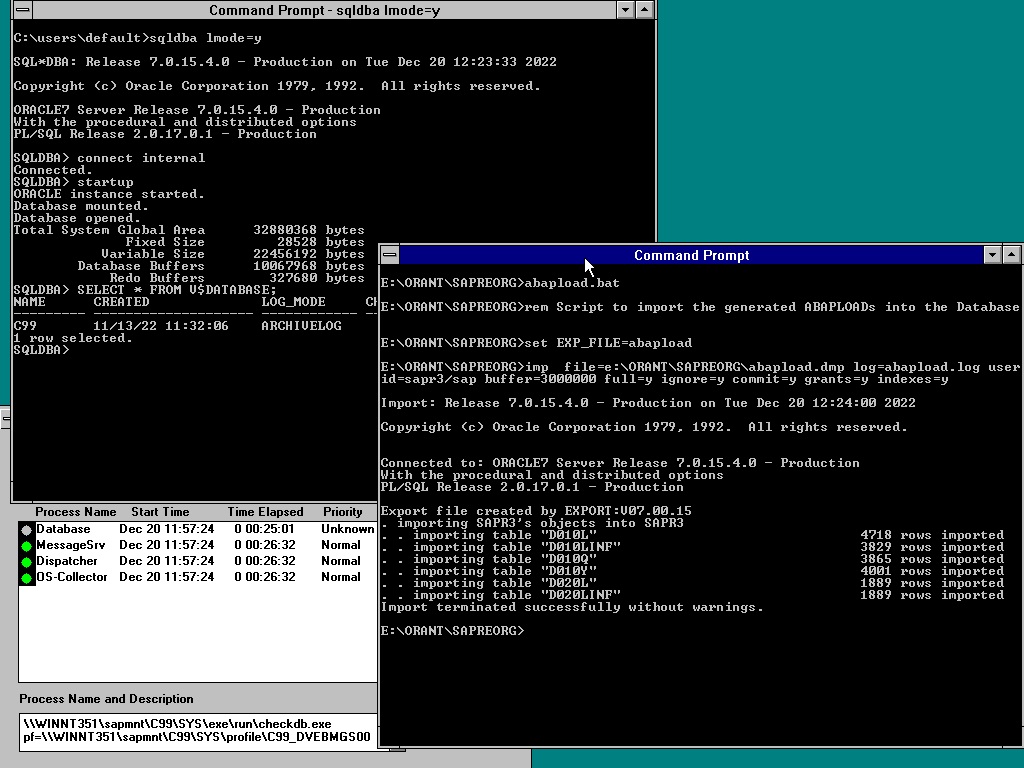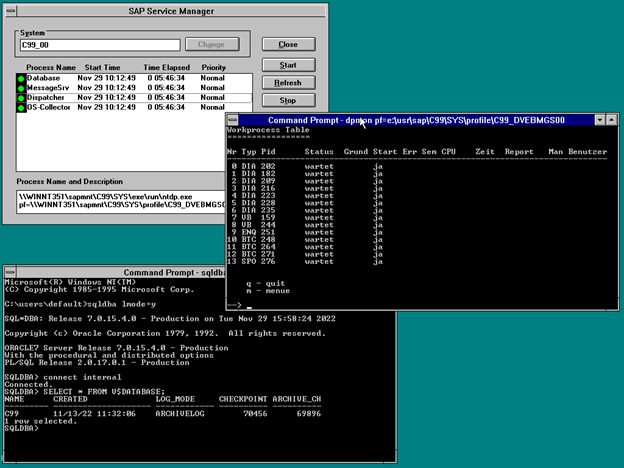
- SAP Community
- Products and Technology
- Enterprise Resource Planning
- ERP Blogs by SAP
- Installing SAP R/3 2.1D
- Subscribe to RSS Feed
- Mark as New
- Mark as Read
- Bookmark
- Subscribe
- Printer Friendly Page
- Report Inappropriate Content
Yes, it's not a typo, it says SAP R/3 2.1D... released in 1994 🙂

Usually I write about the latest tech trends, but this year is SAP's 50th anniversary so to celebrate this significant milestone I wanted to do something special. I am a collector of old computers and software and have a passion for these vintage systems. It's a mix of nostalgia and curiosity for me, since I didn't have the chance to use these machines when I was younger. I have a collection of old servers and hardware from SUN, SGI, CRAY, Apple... and I like to tinker with them occasionally so why not? why not try to find the oldest SAP software still available and see if I could install it.
SAP R/2 was not an option, sadly, it seems that part of SAP's history is lost and there is very little information (even internally) and nevertheless an IBM mainframe was out of my budget. So, I had to settle my expectations for SAP R/3. After some internal digging I found a copy of SAP R/3 2.1D released in 1994 in one of the old file servers at SAP.
Installing SAP R/3 2.1D on Windows NT 3.51 / Oracle 7
Installing Windows NT 3.51 turned out to be more difficult than I initially anticipated, the maximum capacity for the HDD at that time were 4GB so I needed to find special SCSCI drivers to install the additional hard drives as the initial installation of SAP R/3 2.1D requires around 26GB of disk space. Even for this early SAP release the hardware requirements were quite high for the hardware available in 1994.
The installation media could not be more simple, only 2 CDs with several TAR files compressed:
- R21D0010 – CD 1 contains the ORACLE export and the report load.
- R21D0011 – CD2 contains the TAR files for Oracle, the SAP Kernel and the SAP GUI.
The installation process was quite straight forward, first you need to install Oracle 7:

Oracle 7 installation
Before starting the SAP installation tool (R3inst) you need to perform some manual actions:
- Create the filesystems: /oracle/SID, /sapmnt/SID and /usr/sap/SID
- Define the ORACLE and SAP environment variables: SAPTRACE,SAPARCHIVE,…
- Define the EXPDIR environment variable and uncompress the Oracle dump file there

ORA and SAP environment variables
Once you have completed this manual actions you can start the R3inst tool. This tool will create the SID database and import the oracle dump. If I am not mistaken R3inst was the original installation tool for the first SAP R/3 versions. Years later the R3inst tool was replaced by R3SETUP and later with the SWPM.

R3inst tool

Importing the ABAP report load manually
Upon completing the installation, you can use the SAP Service Manager to start the database and the SAP application server. Once they are running, you can use dpmon to verify that the dispatcher and work processes are functioning properly. It's worth noting that in this version, the dispatcher process was referred to as ntpd.exe rather than disp+work.exe like in newer versions. However, all other aspects of the kernel are the same as in later versions.

SAP Service Manager and dpmon
Testing SAP R/3 2.1D
Logging in to SAP for the first time with the username SAP* and the default password 06071992 was an exciting moment!

First logon with SAP*
It was surprising to find that there was no license check, as it appears that the licensing mechanism was not implemented until SAP R/3 3.0A as you can see below. This is likely because at the time this version of SAP was released, software licensing practices were not as developed and widespread as they are today.

SAP R/3 3.0A license
After conducting an initial check, everything seemed to be in good order. The SICK transaction didn't report any inconsistencies and the STATUS screen indicated that it was release 21D:

It is interesting to see the simplicity of this first version, with its initial menu containing only four main areas:
- Office
- Logistics
- Human Resources
- Tools

SAP R/3 2.1D Initial Menu
Later versions of SAP R/3 included more functionality and business processes, but it appears that this SAP R/3 2.1D version did not have support for Industry Solutions. At least, i have not been able to find any reference to this in the release notes.
As someone with a background in SAP basis, my initial interest was to test all the usual basis transactions, such as SM21, ST02, DB02, SM59, and ST06. It's nice to see that all of these transactions were already available in this early version, and that the core functionality was already present.

SM51 - Overview of Processes
Checking the transaction DB02, we can see that the initial installation of the SAP R/3 2.1D version requires around 12GB of data and contains only 1488 tables, it seems quite simple compared to modern versions like SAP ERP 6.0, which has more than 100,000 tables:

The ABAP/4 editor (transaction SE80), renamed later to ABAP Development Workbench in modern versions of SAP, was available from the first version of SAP R/3. While the ABAP/4 editor in these earlier versions was relatively simple compared to more recent versions, it was still able to be utilized for ABAP development.
I discovered that in SAP R/3 2.1D, the source code for the SAPMSYST program (which handles login) could be viewed and edited using the ABAP/4 editor. However, for security reasons, the source code for this critical program is now protected in modern versions of SAP and cannot be accessed or modified. A protection mechanism at the kernel level has been put in place to prevent any attempts to alter the source code of the SAPMSYST program.

ABAP/4 editor - SE80
From a functional point of view, I didn't explore too much but I was nice to see well known transactions like VA01 were already there in version 2.1D:

VA01 - Create a sales order
Final thoughts
The goal of this blog post was not to conduct a thorough analysis of a software that was released almost 30 years ago. As mentioned at the beginning, the main purpose was to pay tribute to the history of SAP and to have fun playing with software that was released when I was still in high school.
There are a few thoughts that come to mind when considering this early version of SAP R/3:
- It is impressive how simple and basic this version was compared to modern versions, yet SAP has managed to maintain the same core functionality over the years while adding new capabilities and business processes. This consistency and stability is likely a key factor in SAP's success.
- The solid architecture of SAP R/3 has allowed the product to evolve and add new functionality over the years with minimal changes. When significant changes were needed, such as the introduction of EhP, HANA, and FIORI, they were implemented without disrupting the existing installed base and maintaining compatibility with it. This speaks to the flexibility and adaptability of SAP R/3."
It is always interesting to look back at the history of a technology or software product and see how it has evolved over the years. It has been fun... but now it's time to come back to 2022 and SAP S/4HANA.
- SAP Managed Tags:
- SAP R/3
You must be a registered user to add a comment. If you've already registered, sign in. Otherwise, register and sign in.
-
Artificial Intelligence (AI)
1 -
Business Trends
363 -
Business Trends
24 -
Customer COE Basics and Fundamentals
1 -
Digital Transformation with Cloud ERP (DT)
1 -
Event Information
461 -
Event Information
24 -
Expert Insights
114 -
Expert Insights
159 -
General
1 -
Governance and Organization
1 -
Introduction
1 -
Life at SAP
415 -
Life at SAP
2 -
Product Updates
4,684 -
Product Updates
219 -
Roadmap and Strategy
1 -
Technology Updates
1,502 -
Technology Updates
89
- User password forgotten/reset in Enterprise Resource Planning Q&A
- FP2402 New Installation in Enterprise Resource Planning Q&A
- Quick Start guide for PLM system integration 3.0 Implementation/Installation in Enterprise Resource Planning Blogs by SAP
- FINS_ACDOC_PLANNING 009 Category doesn't exist and FINS_ACDOC_CUST602 in Enterprise Resource Planning Q&A
- When installing the 32 bit DI API installer, it is not registering DI API properly (SAP B1 v10 240) in Enterprise Resource Planning Q&A
| User | Count |
|---|---|
| 11 | |
| 10 | |
| 9 | |
| 7 | |
| 7 | |
| 7 | |
| 6 | |
| 5 | |
| 4 | |
| 4 |